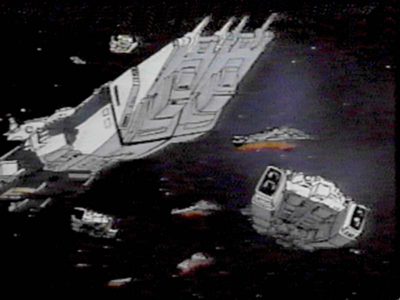
by Peter Walker and Pieter Thomassen

by Peter Walker and Pieter Thomassen
Designation:Yamato class Aerospace Research/Transport (AX/T). |

|
||||

|
|||||
| AX/T-01 | Yamato | NNS | Commissioned 2006 | Destroyed 2009 in Earth orbit |
| AX/T-02 | Arcadia | NNS | Commissioned 2007 | Destroyed 2009 in Earth orbit |
| AX/T-03 | Thunderbird | VSEL | Commissioned 2007 | Destroyed 2009 in Earth orbit |
| AX/T-04 | Liberator | RDY | Commissioned 2006 | Destroyed 2009 in Earth orbit |
| AX/T-05 | Tardis | KW | Commissioned 2006 | Destroyed 2009 in Earth orbit |
These ships were built by the Newport News Shipbuilding (NNS, Newport News, USA), Vickers Shipbuilding and Engineering Limited (VSEL, Barrow-in-Furness, UK), Rotterdam Dockyard Company (RDY, Rotterdam, Netherlands), and Kobe Works (KW, Kobe, Japan) shipyards
The Yamato class is a 'catch-all' name for five large hulls of submersible warships, appropriated by the RDF Spacy. The hulls themselves come from two different classes of vessel; three were begun asPrometheus class sea-going carriers, and two were begun as Daedalus class sea-going landing ships. Since these hulls were all used for the same purpose with much the same engine and electronics fit, they are commonly referred to as the 'Yamato' class, even though of two different hull designs.
The Prometheus and Daedalus classes were being built for the UN Navy as submersible capital ships. When the first seven vessels were on the ways, the RDF Spacy developed a need for large hulls to test anti-gravity theorems and machinery on. Three of the Prometheus class and two of the Daedalus class were (despite vocal protestations of the RDF Navy) transferred to the Spacy, which converted them to airtight hulls and removed all oceanic-related items such as reactors, anchors, propulsors and the like. The hangar bays were cleared of equipment and in the resulting spaces four large Reflex furnaces and the experimental anti-gravity systems were placed. The propulsors were replaced with reaction engines, and the aviation gas and ballast tanks were fitted for reaction mass stowage. Their engine and furnace configurations fluctuated wildly with every progression the Robotech Research Groups made into the Robotechnology, until they finally stabilized to the configuration mentioned above. The vessels were extensively automated, and required only a skeleton crew. Save for their purely research taskings, the class's anti-gravity systems and large upper decks were used to transport bulk cargo from the surface into low Earth orbit.
Externally, they differed little from their oceanic brethren, although they had a central conning tower and a different aft-end due to the reaction engines. This gave the class, when in space, the suggestion of being mislaid oceanic vessels, and they were the butt of many jokes whilst in service.
In 2008-2009, the class was converted into remote controlled target vessels and decoys, to be used for training purposes. Only when docked would a crew take possession of the ships. In an emergency, the ships could serve as decoys in a sudden attack. Plans were made to remove the bows of the vessels and put in the spaces freed a quadruple particle cannon installation based on the Oberth class. This, in addition to furnace and engine upgrades, would have given the ships the equivalent firepower of a destroyer. The intent was to let these ships serve as mobile gun emplacements over Luna and the L-5 factories, until sufficient ARMD, Oberth and Macross class ships had been produced. However, the Zentraedi arrival and loss of the class made this impossible.
After the crash-landing of the SDF-1 on what was named Macross Island, research into the technology of the crashed ship had top priority. In an attempt to remain in the running in a space war and field a modern and useful force, the UN Navy embarked on the construction of the submersible Prometheus and Daedalus class carriers and landing ships.
However, the Spacy remained the premier agency, and when this organization developed a requirement for hulls of Prometheus and Daedalus size as mounting points for the new, experimental propulsion and other systems coming out of the labs, five of the first seven ships were transferred to the Spacy, which renamed and utilized them for anti-gravity and propulsion experiments. They also served as the premier Earth-to-orbit bulk cargo haulers. This cargo was made up of, among other items, translunar transport ships and the first embryonical Lunar mining outpost. It was the cheap orbital bulk transportation duties performed by the Yamato class which enabled the fast establishment of Lunar ore production centers, which in turn created the L-5 and Lunar shipyards, which then created the Orbital Fleet and established Terran outposts in the outer system.
Much to the chagrin of the Navy, these five hulls were declared obsolete in 2008, but instead of being returned to the Navy, which would have preferred to refit them to their original design, the Spacy converted their 'Yamato' class vessels into remote-controlled decoys and target vessels, with a long term plan of converting them into mobile cannon emplacements. As decoys, these five hulls performed beyond expectation, all being destroyed in the first Zentraedi contact after deploying with the orbital fleet. However, even after their destruction the vessels still yielded important data; the SDF-1 computers contained most designs on their technical reconstructions, and this knowledge was later used to refit the hulls of the fourth Prometheus class carrier and the first Daedalus class vessel for space duty as the SDF-1's 'arms'.
Return to RDF Naval index.
Go to Robotech Reference Guide Home Page
Robotech (R) is the property of Harmony Gold. This document is in no way intended to infringe upon their rights.
Content by Pieter Thomassen and Peter Walker